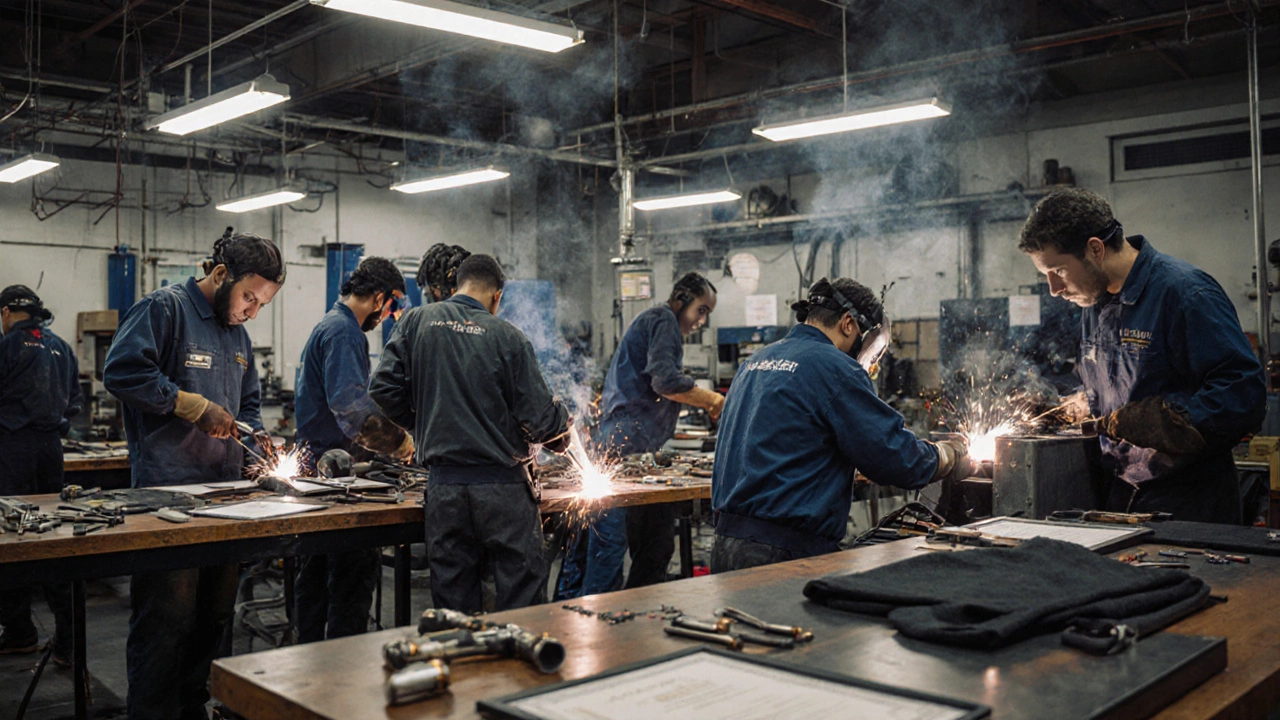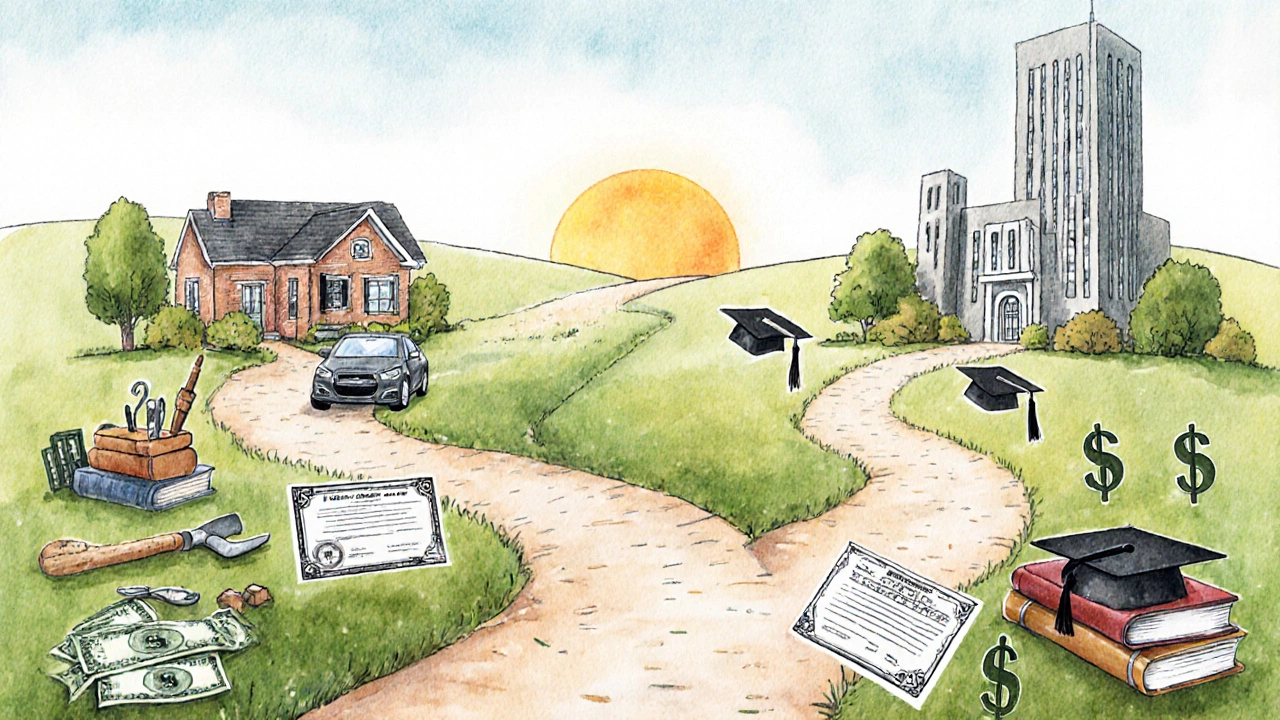Career Path Decision Tool
Which Path Is Right for You?
Answer these questions to find out whether vocational training or traditional education is better suited for your goals.
Important: There's no right or wrong choice - just what's best for you.
1. How soon do you need to start earning money?
2. What's your preferred learning style?
3. How much financial commitment are you comfortable with?
4. What kind of career do you want?
5. What's most important to you?
Your Career Path Recommendation
We're calculating your recommendation...
Your path will appear here...
Estimated Time to Start Working
---
Typical Cost Range
---
Best For
---
People often use the words vocational and educational like they mean the same thing. But they don’t. Mixing them up can lead to bad choices-especially when you’re deciding what to do after high school or how to switch careers. If you want to start working fast, earn a steady paycheck, and learn by doing, vocational training might be your best bet. If you’re aiming for a degree, research, or a job that requires formal credentials like a license or advanced certification, then traditional education is likely the way to go.
What Vocational Training Actually Means
Vocational training is about learning a specific skill you can use right away in a job. It’s not about theory. It’s about doing. Think electricians, plumbers, cosmetologists, welders, medical assistants, and CNC machine operators. These are all careers built on hands-on training, not lectures.
Vocational programs usually last from a few weeks to two years. Most are offered through community colleges, trade schools, or apprenticeships. You don’t need to sit through four years of general education classes. You learn how to install wiring, fix a broken pipe, apply makeup for film, or program a CNC machine-all in focused, practical modules.
In the U.S., the Bureau of Labor Statistics reports that jobs like HVAC technicians and dental hygienists, which require vocational training, pay over $50,000 a year on average-with some earning more than $70,000. And you can start earning that money two years faster than someone in a four-year college program.
What Educational Paths Look Like
When people say "education," they usually mean academic learning. That’s high school, college, university-degrees like a Bachelor’s, Master’s, or PhD. The goal here isn’t just to learn how to do a job. It’s to understand systems, theories, and concepts. You study history, philosophy, calculus, or literary analysis. You write essays, take exams, debate ideas, and build critical thinking skills.
These programs are designed to prepare you for roles that need deep knowledge, research, or leadership. Teachers, engineers, doctors, lawyers, scientists, and professors typically come from this path. A medical doctor doesn’t just need to know how to stitch a wound-they need to understand anatomy, pharmacology, ethics, and research methods. That takes years of layered learning.
Most academic degrees take at least four years. Many require more. And while they open doors to higher-paying roles over time, they also come with higher upfront costs. The average student loan debt in the U.S. in 2025 is around $37,000. That’s a big price tag for a degree that doesn’t always guarantee a job right out of school.
Key Differences at a Glance
Here’s how vocational and educational paths really differ-not in value, but in structure and outcome:
| Aspect | Vocational Training | Academic Education |
|---|---|---|
| Primary Goal | Learn a job skill to start working quickly | Gain broad knowledge and critical thinking skills |
| Typical Duration | 3 months to 2 years | 2 to 8+ years |
| Cost | $1,000-$15,000 total | $15,000-$100,000+ |
| Learning Method | Hands-on labs, apprenticeships, simulations | Lectures, readings, exams, research papers |
| Credentials Earned | Certificate, diploma, license, apprenticeship completion | Associate, Bachelor’s, Master’s, PhD |
| Job Start Timeline | Within months | After graduation (often 4+ years) |
| Typical Industries | Construction, healthcare support, automotive, beauty, IT support | Law, medicine, academia, engineering, management |

Who Benefits From Each Path?
Vocational training works best for people who:
- Prefer learning by doing, not reading
- Want to enter the workforce quickly
- Don’t want to take on large student loans
- Are drawn to hands-on, physical, or technical work
- Live in areas with strong demand for skilled trades
Academic education fits people who:
- Want to work in fields that require a degree by law (like teaching or nursing)
- Enjoy deep research, writing, or abstract thinking
- Are aiming for leadership, management, or research roles
- Are willing to invest time and money for long-term career growth
- Plan to go to graduate school later
There’s no right or wrong choice here. But there is a mismatch that happens too often. I’ve seen students spend $100,000 on a liberal arts degree, then end up working as a retail manager because they didn’t learn any marketable skills. I’ve also seen skilled tradespeople earn more than college grads in their 30s-without ever stepping into a lecture hall.
Can You Do Both?
Yes. And more people are doing it.
Many vocational programs now offer credits that transfer to community colleges. A certified nursing assistant (CNA) can later earn an associate’s degree in nursing. A welder who completes an apprenticeship can go on to get a bachelor’s in engineering technology. The lines are blurring.
Some employers even pay for employees to get degrees while they work. Companies like Amazon, Home Depot, and UPS offer tuition assistance for workers in skilled trades who want to move into management or technical roles.
It’s no longer an either-or choice. It’s a path. You start with a certificate, gain experience, then add a degree if you need it. Or you start with a degree, then get a certification to specialize. The key is knowing what you want to do-not what you think you’re supposed to do.

Common Misconceptions
There are myths around both paths that hold people back.
Myth 1: Vocational training is for "less smart" people. That’s false. Vocational jobs require precision, problem-solving, and adaptability. A good electrician doesn’t just follow wires-they diagnose electrical faults, read blueprints, and adjust for building codes. That’s not easy. It’s not lesser.
Myth 2: College is the only way to a good life. In 2025, 40% of U.S. jobs don’t require a four-year degree but still pay over $55,000 a year. Many of those are in healthcare, IT, and skilled trades. A certificate in cybersecurity or medical coding can get you there faster and cheaper.
Myth 3: You can’t move up from vocational work. Wrong. Many skilled tradespeople become business owners, instructors, or consultants. Some even transition into engineering or project management roles after gaining experience and certifications.
How to Decide What’s Right for You
Ask yourself these questions:
- What do I enjoy doing? (Fixing things? Helping people? Solving puzzles? Writing?)
- How soon do I need to earn money?
- Am I okay with learning on the job, or do I need a formal degree to feel qualified?
- What do the jobs in my area actually pay? (Check local job boards-don’t guess.)
- Do I want to work with my hands, or with data, people, and ideas?
There’s no shame in choosing a vocational path. In fact, with labor shortages in skilled trades, these jobs are in higher demand than ever. Employers are offering signing bonuses, paid training, and flexible schedules to attract workers.
And if you’re still unsure? Try a short course. Many community colleges offer free or low-cost intro classes in welding, coding, or medical assisting. Spend a few weeks. See if you like it. Then decide.
Your future doesn’t have to follow a script. It just has to fit you.
Is vocational training considered education?
Yes, vocational training is a form of education-but it’s not the same as academic education. It’s practical, skills-based learning designed to prepare you for a specific job. It counts as education in the eyes of employers and government agencies, especially when it leads to certifications or licenses.
Can I go to college after vocational training?
Absolutely. Many community colleges accept credits from vocational programs. If you’ve earned a certificate in IT support or medical assisting, you can often transfer those credits toward an associate’s or even a bachelor’s degree. Some universities even offer accelerated paths for working professionals with trade backgrounds.
Do vocational jobs pay well?
Yes, many do. In 2025, the median salary for skilled trades like electricians, plumbers, and HVAC technicians is between $55,000 and $75,000 in the U.S. Some specialized roles, like nuclear technicians or radiation therapists, pay over $80,000. These jobs often come with benefits, overtime pay, and job security.
Why is vocational training less talked about than college?
For decades, society pushed the idea that college was the only respectable path. Media, parents, and even schools often ignored skilled trades as "second choice." But that’s changing. With labor shortages and rising student debt, more people are realizing that vocational training offers a faster, cheaper, and just as valuable route to a stable career.
Are vocational courses recognized internationally?
Recognition varies by country. In Germany, Australia, and Canada, vocational training is highly respected and integrated into the education system. In the U.S., it’s improving but still less standardized. If you plan to work abroad, check if your certification is accepted in that country-some require additional exams or local licensing.

